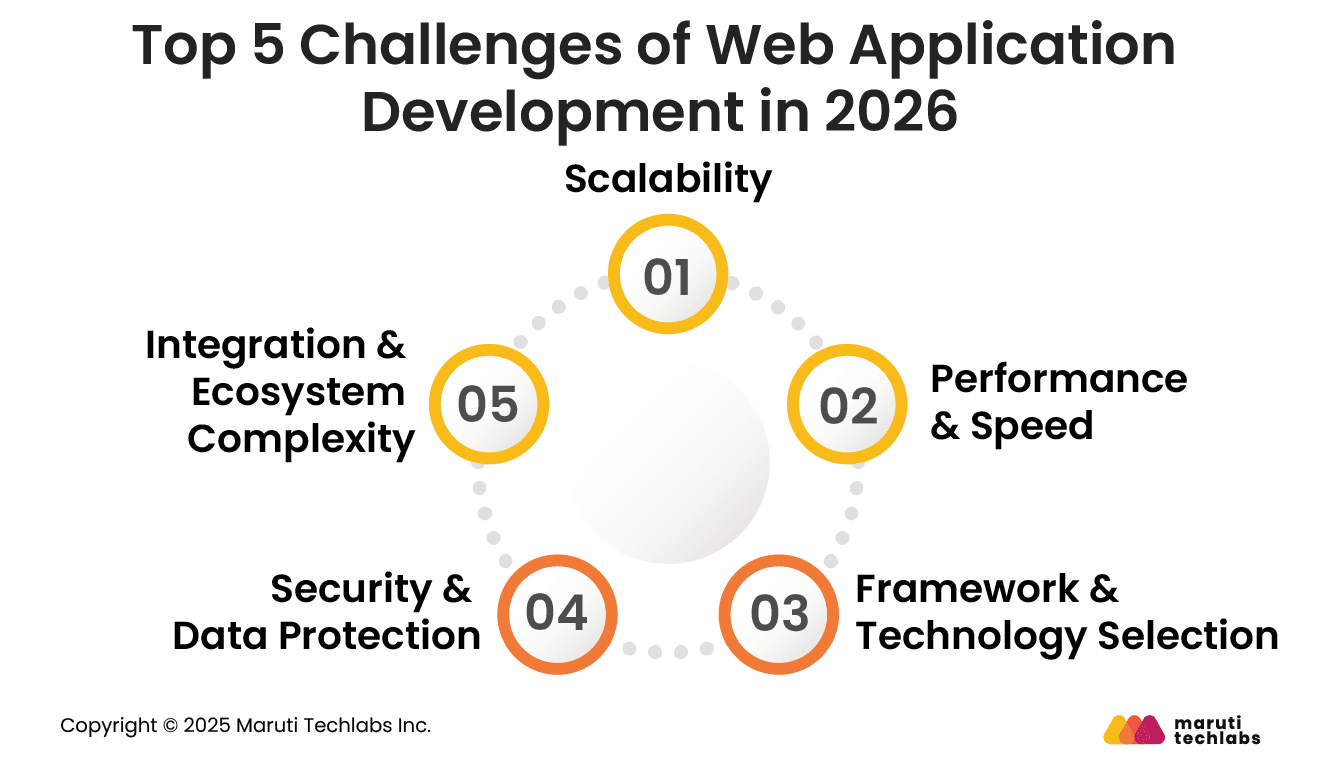

Navigating the Top 5 Challenges of Web Application Development






Web application development remains a complex and ever-evolving field, demanding a balance between functionality, performance, and user experience.
Developers face growing challenges as user expectations rise. Modern web apps must be fast, intuitive, secure, and accessible across multiple devices. Meanwhile, the rapid evolution of technologies, frameworks, and tools adds another layer of difficulty, requiring teams to adapt and innovate constantly.
Integrating new features, ensuring scalability, and maintaining consistent design standards further heighten the challenge.
This blog explores why web development remains demanding despite advancements, examining the key factors driving complexity and shifting expectations. It also offers practical insights into developing future-ready web applications in an increasingly competitive digital landscape.
Web development faces multiple challenges—from ensuring scalability, performance, and speed to choosing the right technologies and maintaining robust security. Each factor demands careful planning and execution to deliver reliable, high-performing, and secure applications that meet evolving user and business needs.
Let’s briefly examine these challenges and how to mitigate them.

As web applications become more popular, scalability becomes a critical challenge. Handling increasing users, data, and transactions without compromising performance requires thoughtful planning and resilient architecture.
Scalability issues arise when applications fail to handle growing loads efficiently. As users and data grow, the underlying infrastructure, such as servers, databases, and APIs, can become bottlenecks, leading to performance degradation and instability. Without foresight, systems built for small-scale use often struggle to adapt to enterprise-level demands.
Poor scalability leads to slow page responses, downtime, and system outages during peak traffic. This not only impacts user satisfaction but also damages brand credibility and revenue. For example, an e-commerce site crashing on sale days can lose thousands of potential transactions within minutes.
To address scalability, adopt flexible architecture patterns like microservices, load balancing, and serverless computing. These enable distributed workloads and resource elasticity. Planning for growth early through capacity testing, auto-scaling, and modular design ensures smooth performance as demand rises.
Netflix exemplifies scalability success. By migrating to a microservices and cloud-based architecture, it seamlessly supports millions of concurrent users worldwide and adapts in real time to traffic spikes without service interruption.
Website performance and speed are vital to user satisfaction and retention. Slow-loading pages or laggy interactions can quickly drive users away, impacting both engagement and business outcomes.
Performance issues often stem from significant media assets, unoptimized scripts, inefficient database queries, and excessive server requests. As websites grow more feature-rich, these inefficiencies compound, leading to longer load times and poor responsiveness, especially on mobile or low-bandwidth networks.
Users expect near-instant responses. Delays of more than 3 seconds often lead to drop-offs. Poor speed not only frustrates visitors but also affects SEO rankings, as Google prioritizes faster websites. In e-commerce, even a one-second delay can significantly reduce conversions and revenue.
Developers can improve performance by using Content Delivery Networks (CDNs), browser caching, lazy-loading images, and performance profiling. These techniques minimize data transfer, reduce server strain, and optimize rendering, ensuring faster, smoother page experiences for users across devices and geographies.
Tools like Google Lighthouse, GTmetrix, and WebPageTest help analyze speed and identify bottlenecks. Key metrics such as Largest Contentful Paint (LCP), Time to Interactive (TTI), and Core Web Vitals provide benchmarks for systematically optimizing performance.
Amazon famously reported that every 100ms increase in page load time reduced sales by 1%. By continuously optimizing assets and server responses, Amazon ensures fast, seamless shopping experiences for millions of customers worldwide.
Selecting the right frameworks and platforms is one of the most crucial and often most difficult decisions in web development. The wrong choice can limit growth, increase costs, and hinder innovation.
Many teams struggle to choose among numerous frameworks, languages, and tech stacks. The challenge deepens when skilled developers for a chosen technology are scarce, slowing down development and creating long-term dependency on a limited talent pool.
An unsuitable tech stack can lead to higher maintenance costs, poor performance, and scalability limitations. Frameworks that lack community support or compatibility can quickly become obsolete, forcing costly rewrites or migrations as project requirements evolve.
Tech decisions should align with business goals, team expertise, and scalability needs. Evaluating long-term product vision, integration requirements, and ecosystem maturity helps ensure the chosen stack supports sustainable, adaptable development over time.
Onboarding, continuous training, and regular architecture reviews are essential for maintaining technical alignment. Encouraging learning programs and cross-functional collaboration helps teams stay up to date with new technologies and make informed choices in future projects.
Security remains one of the most critical yet overlooked aspects of web development. Protecting applications from breaches and misuse is essential to preserve user trust and maintain compliance.
Web applications face constant risks, including cross-site scripting, SQL injection, cross-site request forgery, and data breaches. These vulnerabilities can expose sensitive information, disrupt operations, and damage reputations if not addressed through proper coding and validation practices.
Many teams underprioritize security due to tight deadlines, limited budgets, or a lack of awareness. As a result, vulnerabilities are discovered post-deployment, making them more costly and disruptive to operations.
MoldStud experienced vulnerabilities due to unvalidated user input that exposed confidential client data. The company enhanced its security posture by implementing strict input sanitization and routine penetration tests, significantly reducing the risk of malicious exploitation and unauthorized access.
Adopting secure coding practices, performing regular security audits, and conducting penetration testing are vital. Using encryption, enforcing strong authentication and authorization, and following security frameworks ensure proactive protection against evolving cyber threats.
Modern web applications rarely operate in isolation. Integrating with third party services, APIs, and legacy systems introduces complexity that requires careful planning, coordination, and ongoing management.
Integrations involve multiple systems communicating seamlessly in real time. Each service comes with unique protocols, authentication methods, and data formats. Managing these differences while ensuring stability and security can be daunting, especially as systems evolve independently.
Trango Tech encountered frequent disruptions when integrating its customer portal with third party payment and CRM services. By introducing structured API management, continuous monitoring, and redundancy layers, the company improved reliability, reduced downtime, and maintained data integrity across connected systems.
Common challenges include API version mismatches, inconsistent data synchronization, and downtime caused by external dependencies. When one connected service fails or changes unexpectedly, it can cascade into larger outages that affect user experience and operational continuity.
Strong API governance, fallback strategies, and real-time monitoring help minimize integration risks. Choosing reliable technology partners and clearly defining service level expectations ensures smooth interoperability and predictable performance even under demanding conditions.
Integrations often involve data sharing across systems, making compliance essential. Organizations must follow relevant standards such as GDPR or industry-specific mandates, ensuring that data transfers remain secure, auditable, and aligned with privacy regulations.
Selecting the right tools and frameworks defines how effectively teams can build, scale, and secure web applications. The right stack simplifies complexity, boosts productivity, and ensures long-term stability.
Contemporary web stacks such as MERN, MEAN, and JAMStack enable faster development through reusable components, cloud readiness, and flexible integrations.
These frameworks enhance scalability, simplify deployment, and support modular design, allowing teams to deliver robust, responsive, and easily maintainable web applications.
Frameworks like React, Angular, and Django help streamline workflows, while backend platforms such as Node.js and Flask improve speed and scalability.
Adopting DevOps practices, including continuous integration, automated testing, and containerization, ensures faster releases and consistent quality throughout the development lifecycle.
Performance optimization tools such as Google Lighthouse, WebPageTest, and New Relic help monitor speed and resource usage.
For security, solutions such as OWASP ZAP, Snyk, and automated vulnerability scanners detect risks early, enabling teams to safeguard applications before deployment and maintain user trust.
At Maruti Techlabs, our expert team provides top-notch custom web app development service tailored to your business needs. As a leading web application development company, we specialize in creating custom web apps that are scalable, secure, and intuitive. Let us help you elevate your online presence with our cutting-edge technology and personalized approach to development.
Explore how our custom web application development services Chicago can drive growth for your business—designed to meet the needs of companies in the Windy City and beyond.


